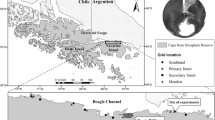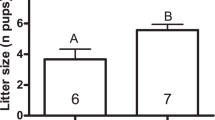Abstract
There are numerous studies showing that predation risk may change different aspects of the behavior of prey, such as habitat use, activity pattern, and foraging. Prey should exhibit the strongest antipredatory response against their most deadly predator. Small mustelids are considered the most important mammalian predators of voles. Nevertheless, there is no general agreement as to whether strong antipredatory reactions exist in natural free-living populations of voles. Here, we studied the field vole Microtus agrestis spatial reaction to high predation risk from small mustelids in the breeding (August) and nonbreeding (October) seasons under natural conditions. Voles were exposed to a caged weasel (Mustela nivalis) and a stoat (Mustela erminea), as well as to the odors of these predators. The reactions of 30 field voles were monitored with radiotelemetry. The field voles were found to display antipredator reactions that varied with season. In the breeding period, in response to predation risk, voles reduced locomotory activity and daily-range size, whereas in the nonbreeding period they did not. Changes in home range position were similar for control and treatment voles, in both the breeding and nonbreeding periods. The results indicate that mustelid predators modify the spatial behavior of small rodents in natural conditions depending on season. This might be a reflection of differences in state-dependent responses to predation from sexually active or inactive individuals. This suggests that the basic antipredatory reaction of voles under high predation risk from small mustelids limits their locomotory activity.


Similar content being viewed by others
References
Agrell J (1995) A shift in female social organization independent of relatedness: an experimental study on the field vole (Microtus agrestis). Behav Ecol 2:182–191
Banks PB, Norrdahl K, Korpimäki E (2000) Nonlinearity in the predation risk of prey mobility. Proc R Soc Lond B 267:1621–1625
Bergeron JM, Jodoin L (1995) Winter use of food by fenced voles (Microtus pennsylvanicus). Can J Zool 73:907–915
Borowski Z (1998a) Influence of predator odour to feeding behaviour of the root vole (Microtus oeconomus Pallas, 1776). Can J Zool 76:1791–1794
Borowski Z (1998b) Influence of weasel (Mustela nivalis Linneaus, 1776) odour on spatial behaviour of root voles (Microtus oeconomus Pallas, 1776). Can J Zool 76:1799–1804
Borowski Z (2000) The odour of terrestrial predator as an olfactory risk signal detected by rodents, and its consequences. Biol Bull Pozn 37:59–169
Borowski Z (2002) Individual and seasonal differences in antipredatory behaviour of root voles—a field experiment. Can J Zool 80:1520–1525
Brown JS (1988) Patch use as indicator of habitat preference, predation risk and competition. Behav Ecol Sociobiol 22:37–47
Brown JS, Laundré JW, Gurung M (1999) The ecology of fear: optimal foraging, game theory, and trophic interactions. J Mammal 80:385–399
Calder CJ, Gorman ML (1991) The effects of red fox Vulpes vulpes fecal odours on the feeding behaviour of Orkney voles Microtus arvalis. J Zool 244:599–606
Carlsen M, Lodal J, Leirs H, Jensen TS (1999) The effect of predation risk on body weight in the field vole, Microtus agrestis. Oikos 87:277–285
Cushing BS (1985) Estrous mice and vulnerability to weasel predation. Ecology 66:1976–1978
Desy EA, Batzli GO, Liu J (1990) Effects of food and predation on behaviour of prairie voles a field experiment. Oikos 58:159–168
Dickman CR (1992) Predation and habitat shift in the house mouse, Mus domesticus. Ecology 68:1856–1862
Eccard JA, Pusenius J, Sundell J, Halle S, Ylönen H (2008) Foraging patterns of voles at heterogeneous avian and uniform mustelids predation risk. Oecologia 157:725–734
Fuelling O, Halle S (2004) Breeding suppression in free-ranging grey-sided voles under the influence of predator odour. Oecologia 138:151–159
Hansson L (1995) Is the indirect predator effect a special case of generalized reactions to density-related disturbances in cyclic rodent populations? Ann Zool Fennici 32:159–162
Houston AI, McNamara JM (1993) A theoretical investigation of the fat reserves and mortality levels of small birds in winter. Ornis Scand 24:205–219
Ims RA (1987) Male spacing systems in microtine rodents. Am Nat 130:475–484
Jędrzejewski W, Jędrzejewska B (1990) Effect of a predator’s visit on the spatial distribution of bank voles: experiments with weasels. Can J Zool 68:660–666
Jędrzejewski W, Rychlik L, Jędrzejewska B (1993) Responses of bank voles to odour of seven species of predators—experimental data and their relevance to natural predator-vole relationship. Oikos 68:251–257
Jonsson P, Koskela E, Mappes T (2000) Does risk of predation by mammalian predators affect the spacing behaviour of rodents? Two large-scale experiments. Oecologia 122:487–492
Kenward RS (1987) Wildlife radio tagging. Academic Press, London
Korpimäki E, Koivunen K, Hakkarinen H (1996) Microhabitat use and behaviour of voles under weasel and raptor predation risk: predator facilitation? Behav Ecol 7:30–34
Kotler BP, Ayal Y, Subach A (1994) Effects of predatory risk and resource renewal on the timing of foraging activity in a gerbil community. Oecologia 100:391–396
Liesenjohann T, Eccard JA (2008) Foraging under uniform risk from different types of predators. BMC Ecology 8:1–9
Lima SL (1998) Nonlethal effects in the ecology of predator–prey interactions. Bioscience 48:25–34
Lima SL, Bednekoff PA (1999) Temporal variation in danger drives antipredatory behaviour: the predation risk allocation hypothesis. Am Nat 153:649–659
Lima SL, Dill LM (1990) Behavioural decision made under the risk of predation: a review and prospectus. Can J Zool 68:619–640
McNamara JM, Houston AI (1996) State-dependent life histories. Nature 381:215–221
Nonacs P (2000) State dependent behavior and the marginal value theorem. Behav Ecol 12:71–83
Norrdahl K, Korpimäki E (1998) Does mobility or sex of voles affect risk of predation by mammalian predators? Ecology 79:226–232
Ostfeld RS (1985) Limiting resources and territoriality in microtine rodents. Am Nat 126:1–15
Parsons GJ, Bondrup-Nielsen S (1996) Experimental analysis of behaviour of meadow voles (Microtus pennsylvanicus) to odours of the short-tailed weasel (Mustela erminea). Ecoscience 3:63–69
Schmitz OJ, Beckerman AP, O’Brien KM (1997) Behaviorally mediated trophic cascades: effects of predation risk on food webs. Ecology 78:1388–1399
StatSoft Inc (1995) Statistica for Windows—Tulsa. StatSoft, Inc., OK
Sundell J, Dudek D, Klemme I, Koivisto E, Pusenius J, Ylönen H (2004) Temporal variation of fear and vole behaviour: an experimental field test of the predation risk allocation hypothesis. Oecologia 139:157–162
Taylor RJ (1984) Predation. Chapman and Hall, Inc, New York
Tracker (1994) Components AB and Radio Location Systems AB, Stockholm, Sweden. http://ethology.zool.su.se/tracker/
Webster AB, Brooks RJ (1980) Effects of radiotransmitters on the meadow vole. Microtus pennsylvanicus. Can J Zool 58:997–1001
Wolff JO, Davis-Born R (1997) Response of gray-tailed voles to odours of mustelid predator: a field test. Oikos 79:543–548
Ylönen H (2001) Predator odors and behavioural responses of small rodents: an evolutionary perspective. In: Pelz H-J, Cowan DP, Feare CJ (eds) Advances in vertebrate pest management II. Filander Verlag, Fürth, pp 123–138
Ylönen H, Ronkainen H (1994) Breeding suppression in the bank vole as antipredatory adaptation in a predictable environment. Evol Ecol 8:658–666
Acknowledgments
The study was financed by the General Directorate of Polish Forestry (grant BLP-916 to ZB) and the North Atlantic Treaty Organization postdoctoral fellowship to ZB. We are grateful to B. Jędrzejewska, L. Rychlik, and Pehr H. Enckell for their constructive comments on a draft of this paper. This work complies with the current laws of Poland
Author information
Authors and Affiliations
Corresponding author
Rights and permissions
About this article
Cite this article
Borowski, Z., Owadowska, E. Field vole (Microtus agrestis) seasonal spacing behavior: the effect of predation risk by mustelids. Naturwissenschaften 97, 487–493 (2010). https://doi.org/10.1007/s00114-010-0663-1
Received:
Revised:
Accepted:
Published:
Issue Date:
DOI: https://doi.org/10.1007/s00114-010-0663-1




